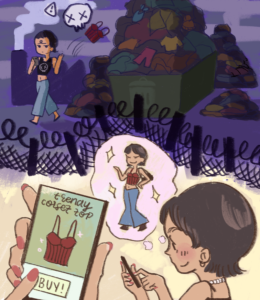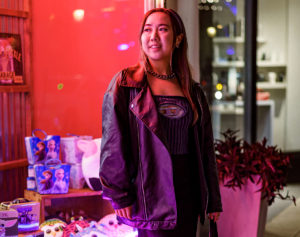This post was updated Feb. 19 at 10:32 p.m.
It’s February, which means you are way behind if you haven’t bought an Owala water bottle to replace your Stanley cup from November. And if you don’t own Adidas Samba shoes by now, have you been living under a rock?
New trends pop up every few days now, with the internet dictating what items of clothing are in style or out of season. Social media facilitates the growing acceleration of the trend cycle, promoting an unsustainable fashion market with both environmental and individual consequences.
Increasing internet visibility of fashion has created a type of fad called the microtrend, a specific item or style that skyrockets into popularity but loses attention very quickly, said Alina Beaman, a second-year statistics and data science student and internal social director of sustainable fashion club RefineLA.
Microtrends work hand-in-hand with fast fashion companies to mass-produce new items that appeal primarily to the demographic of young social media users.
The demand for microtrends, amplified by the affordability and accessibility of fast fashion, completely transformed fashion norms from how they were a few decades ago, said Sarah Koussa, fourth-year global studies student and events director of Fashion and Student Trends at UCLA.
“Back in the ’80s, people were buying around 12 pieces of new clothing a year,” Koussa said. “Today, people are buying around 68.”
SHEIN, a leading fast fashion brand, promotes 10,000 new items per day on its website. Online purchasing can be done with the instant press of a button.
Koussa added that she noticed an increase in the popularity of microtrends during the COVID-19 pandemic. Stay-at-home orders increased media consumption, and more frequent online shopping patterns arose from a culture of anxiety and uncertainty, according to a 2022 study.
Furthermore, scrolling on social media apps like TikTok leads to personal comparison to the image of others and a stronger desire to buy a product you’ve been exposed to many times, Beaman said.
We now look back in shame at the cow prints, sheer tops and stiff tennis skirts that dominated our closets in 2020. However, the end of the pandemic did not signify an end to this proliferation of microtrend consumption.
Since then, new avenues of fast fashion have risen in popularity, expediting the trend cycle and further ingraining purchases with social media use. Blossoming online marketplace Temu increased the ease of purchasing microtrends through its site through an abundance of advertisements on Instagram and even in Super Bowl commercials. Meanwhile, TikTok added a “Shop” tab to its interface last year that incentivizes creators to sell products directly through the app.
“We already had it bad with fast fashion,” said Claudia Rajski, a third-year environmental science student and co-director of social impact at RefineLA. “With TikTok and TikTok Shop adding to it, I think it just makes everyone want certain products more, and they’re a lot more disposable.”
Microtrends incentivize the production and purchase of trendy items with short lifespans. No matter how desirable an object appears on TikTok Shop, however, the majority of fast fashion purchases are quickly discarded as a result of poor material manufacturing or the trend going out of style.
People often don’t consider the longevity of a certain item when they purchase it or where it will go after being disposed of, Rajski added.
According to the United States Environmental Protection Agency, over 11 million tons per year of textiles end up in landfills every year, where they leach toxins into the soil and release harmful greenhouse gasses during a decomposition process that can last over 200 years.
Not only is the continuous consumption of microtrends harmful to the environment, but repeatedly purchasing similar items is an unsustainable lifestyle for those interested in fashion.
The best solution for avoiding microtrends is to buy less and search for more sustainable ways to dispose of clothing, Rajski said.
Rajski and Koussa both said they create capsule wardrobes to minimize their overconsumption of new styles. Maintaining staple items and slowly adding high-quality pieces to one’s closet can help people avoid the pitfalls of microtrends.
An alternative to buying into microtrends is to search for similar styles in more sustainable options that will have a longer closet life than the trending item itself, Koussa said. She participated in the coquette bow trend by thrifting items that implemented the bow style that she liked while still matching her fashion tastes, she said.
“Once you do consume items because you want to express yourself more, look for sustainable ways such as secondhand,” Beaman added.
As college students living in a fashion-oriented city, the pressure to have the newest item can be immense. When these trending products are cheap, heavily marketed and worn all around campus, being told to thrift or abstain can feel unreasonable.
Additionally, sites like SHEIN and other fast fashion companies provide new and unused items that offer an accessible and affordable alternative to the expenses of high-end clothing. As a result, individuals of lower income and those unable to shop in person may be more inclined to purchase clothes from these websites.
Nevertheless, it is imperative to acknowledge that not everyone has the means to thrift. Financial disparities can make efforts to shop sustainably unfeasible for low-income individuals.
“There are people that really just don’t like used clothes, and that’s okay,” Koussa said. “It’s not something to frown upon if people are purchasing from places like H&M and Forever 21, but I think that there needs to be a sense of awareness and being conscious of how much you’re consuming year round.”
The responsibility of promoting sustainable fashion should not fall entirely on the shoulders of consumers, particularly college students, but we must consider the impact of the purchases we make. This involves mindful shopping and holding fast fashion brands accountable for their unethical practices.
Thoughtful consideration of the longevity, necessity and lifespan of a purchase is something anyone can do.
After all, how much do you really need that new microtrend on TikTok Shop? It will likely be out of style by next week.






Comments are closed.